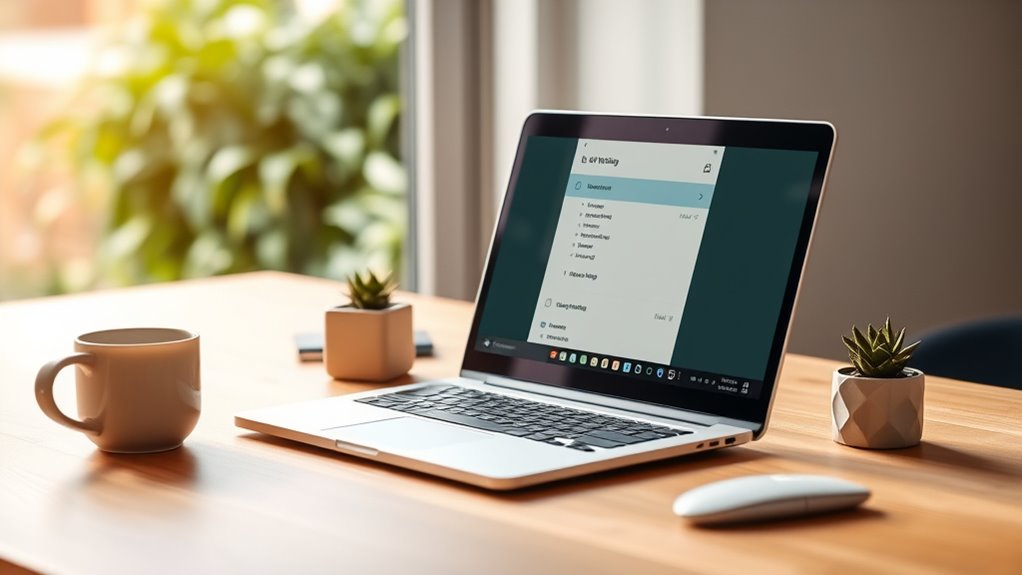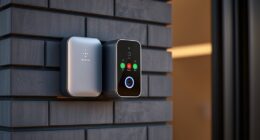Sustainable email habits focus on realistic routines instead of obsessing over achieving inbox zero every day. You should prioritize important messages, filter out noise, and set specific times to check emails, avoiding constant interruptions. Automate sorting and responses where possible, and regularly review and archive messages to stay organized. By establishing consistent habits and managing notifications, you can reduce stress and boost productivity—if you keep exploring, you’ll find practical steps to make this your normal.
Key Takeaways
- Focus on manageable inbox goals and prioritize meaningful engagement over perfection to reduce stress.
- Establish specific, consistent times for checking and responding to emails to build sustainable routines.
- Use filters, automation, and AI tools to organize messages and minimize manual clutter.
- Regularly review, unsubscribe from unnecessary lists, and archive or delete emails to maintain clarity.
- Develop a triage system: delete irrelevant, delegate when possible, and respond promptly to essential messages.
Rethinking the Inbox Zero Philosophy
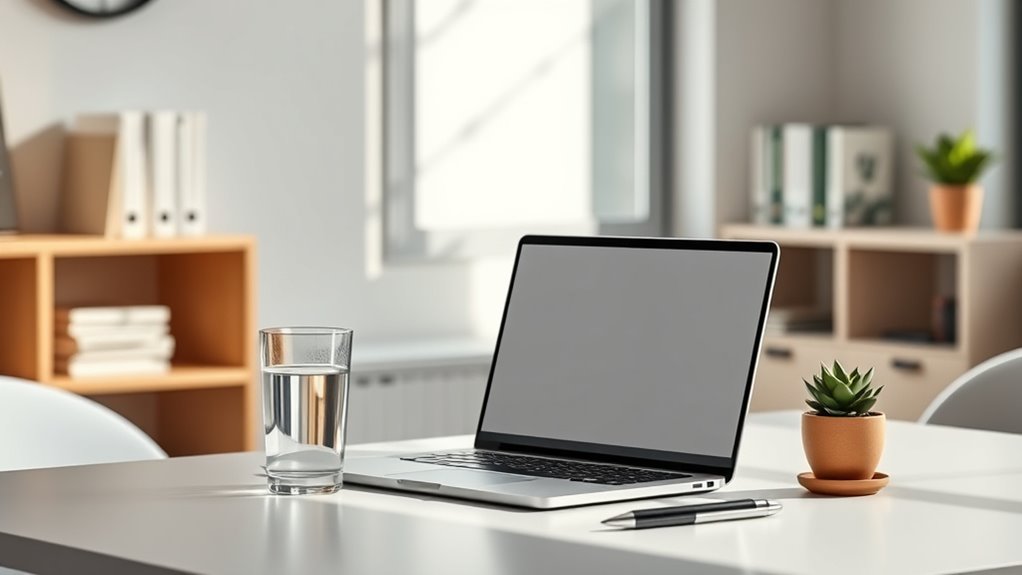
While the idea of achieving and maintaining inbox zero has long been celebrated as the ultimate productivity goal, it’s worth reconsidering whether this approach is always practical or necessary. Aspiring for zero emails can lead to unnecessary stress and perfectionism, especially when some messages require only quick responses or brief acknowledgment. Instead of obsessing over clearing every single email, focus on managing your inbox in a way that supports your workflow. Recognize that not every email demands immediate action or deep attention. Rethinking inbox zero encourages you to prioritize meaningful engagement over perfect cleanliness, reducing burnout. Additionally, understanding the importance of email management can help optimize your approach. Incorporating high-quality content into your email communications ensures clarity and purpose, making your inbox easier to handle. Embracing a space-conscious approach to email habits can also help prevent clutter from accumulating. Being mindful of email overload can further assist in maintaining a sustainable email routine. Ultimately, the goal should be effective email management that aligns with your work habits, rather than an unrealistic pursuit of an empty inbox at all costs.
Setting Realistic Expectations for Email Management
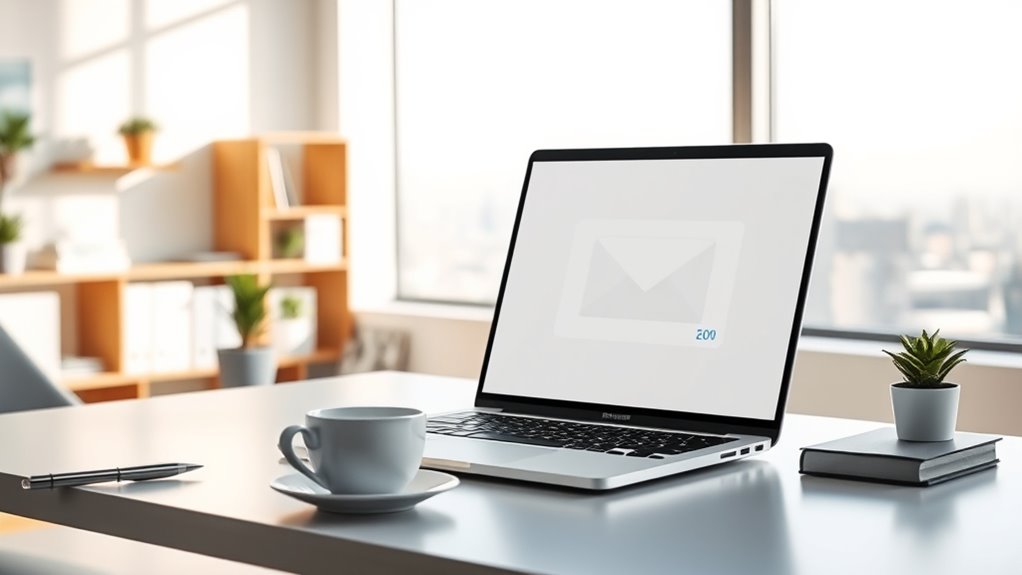
After reconsidering the pursuit of inbox zero, it’s clear that setting realistic expectations is key to sustainable email management. You won’t clear your inbox every day, and that’s okay. Instead, focus on manageable goals that fit your schedule and workload. Accept that some emails will require longer responses or deferred action. This mindset prevents frustration and burnout, making your habits more durable. To set your expectations effectively, consider these points:
Setting realistic email goals prevents burnout and promotes sustainable inbox management.
- Recognize that inbox maintenance is ongoing, not a one-time task
- Prioritize quality over perfection in your email responses
- Allocate specific times for checking and replying, avoiding constant interruptions
- Understand that some emails can be archived or delegated rather than addressed immediately
- Incorporating email organization strategies and leveraging digital tools can further enhance your ability to manage your inbox efficiently, especially when using smart filtering to automatically sort incoming messages. Being mindful of relationship patterns in your communication can also help you identify important messages more easily.
Prioritizing and Filtering for Efficiency
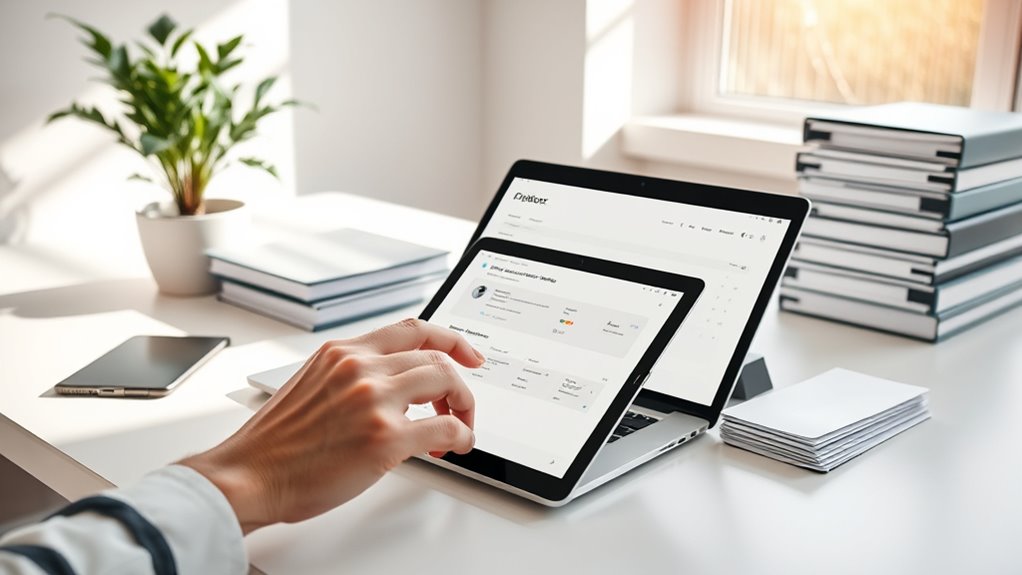
Effective prioritization and filtering are essential for managing your inbox efficiently. By sorting emails based on urgency and importance, you ensure critical messages get your attention first. Use filters to automatically route newsletters, social updates, and promotional emails to designated folders, keeping your main inbox clear. Establish rules for flagging or starring important emails so you can quickly identify them later. Focus on addressing high-priority messages first, and set aside specific times to review less urgent ones. Regularly refining your filters helps prevent inbox clutter and guarantees you’re not overwhelmed. This targeted approach allows you to work smarter, not harder, and keeps your inbox streamlined and manageable. Incorporating email management techniques can further optimize your workflow. Implementing privacy and cookie management best practices ensures your email habits remain secure and respectful of your privacy. Prioritizing and filtering are key steps toward achieving sustainable email habits.
Implementing Smart Email Sorting Techniques

Implementing smart email sorting techniques can considerably enhance your inbox management by automatically organizing incoming messages based on their content and relevance. These techniques save time and reduce clutter, helping you focus on what truly matters. You can set up filters and rules that direct emails into specific folders, such as newsletters, work updates, or personal messages. Using AI-powered tools, emails can be prioritized or marked as important without manual intervention. Additionally, understanding and managing your cookie preferences can improve your browsing experience and privacy controls while optimizing your email management tools. Incorporating Gold IRA insights into your digital routines can also promote a more mindful approach to communication and information management.
Crafting a Consistent Email Routine
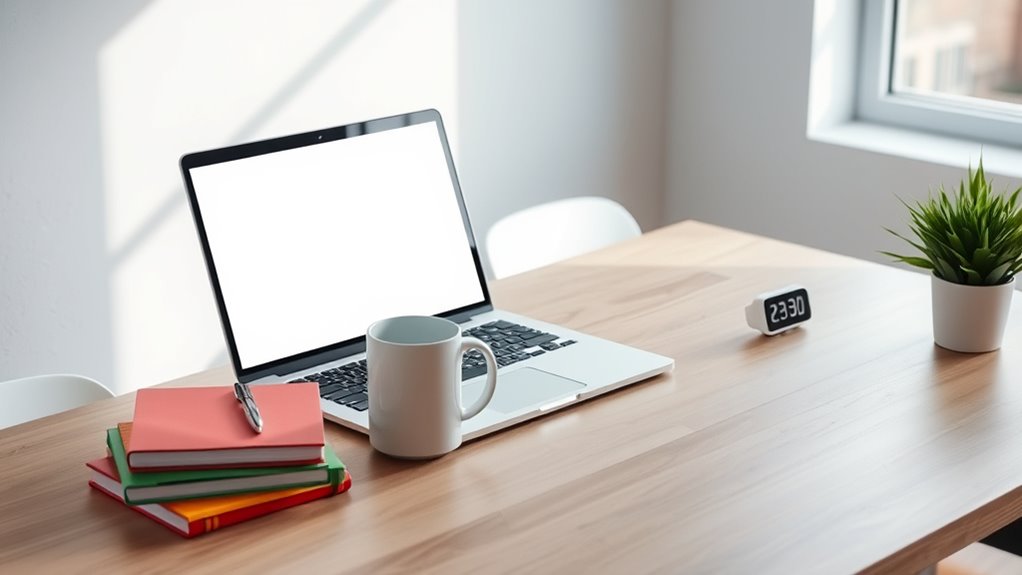
Establishing a consistent email routine helps you stay organized and reduces the stress of managing an overflowing inbox. Decide on specific times during the day to check and respond to emails—perhaps morning, midday, and late afternoon. Stick to these slots to prevent constant interruptions and avoid feeling overwhelmed. Keep your routine simple: prioritize important messages first, then handle less urgent ones later. Use a standard process for managing emails, such as quickly deleting irrelevant messages, replying to quick requests immediately, and flagging emails that need more attention. Over time, this consistency builds a habit that keeps your inbox manageable and prevents backlog. A predictable schedule ensures you stay in control and reduces the mental clutter that comes with sporadic email checks. Incorporating email management techniques and consistent routines can further streamline your workflow and reinforce your routine. Additionally, being aware of your privacy preferences while managing emails can help you control targeted advertising and data sharing, maintaining your online privacy while staying productive.
Utilizing Automation and Tools Effectively
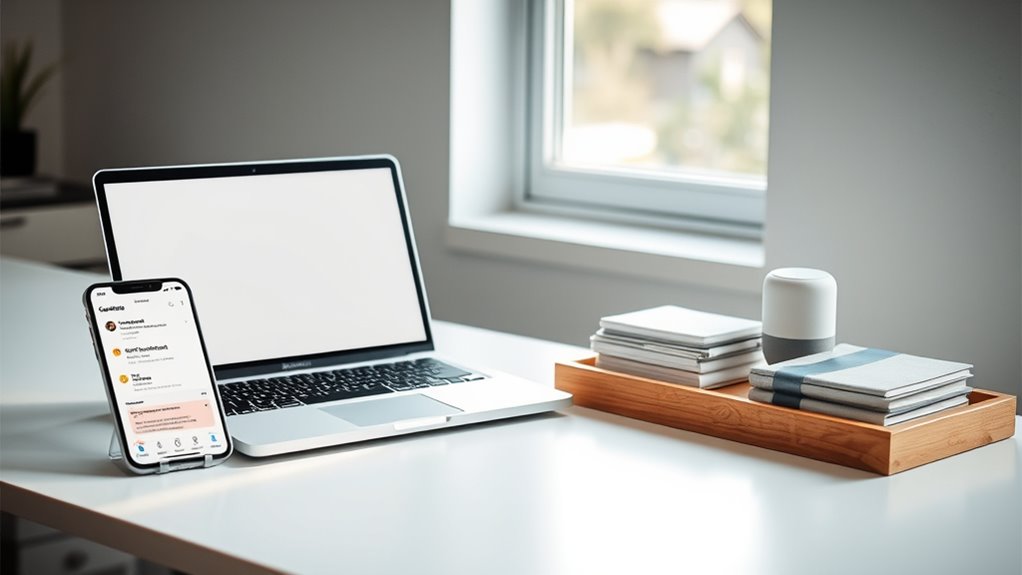
You can save time by automating routine email tasks and setting up smart filters to prioritize messages. Scheduling dedicated times to check your inbox helps prevent constant interruptions. Additionally, integrating privacy and consent management or calming scents into your workspace may improve concentration and reduce stress while managing your inbox. Using tools like email scheduling apps or automated responses can further streamline your communication workflow. Employing stress reduction techniques in your workspace can also enhance focus and overall well-being. By using these tools effectively, you keep your inbox organized and maintain focus on what matters most.
Automate Routine Tasks
Automating routine tasks can substantially reduce the time and mental load required to manage your inbox. By setting up automation, you free yourself from repetitive actions and guarantee your inbox stays organized effortlessly. Use tools to schedule emails, auto-archive old messages, or send quick replies for common questions. This allows you to focus on more important tasks instead of constantly managing your inbox. To get started, consider these options:
- Create email filters to automatically sort incoming messages
- Set up autoresponders for common inquiries
- Use scheduling tools to send emails at ideal times
- Automate follow-up reminders for pending tasks
- Be aware of family dynamics and how they can influence your personal and professional life, helping you maintain better emotional balance while managing your email habits. Incorporating tuning principles from vehicle customization can inspire systematic adjustments to your email management strategies, making them more efficient and tailored to your needs. Additionally, understanding how emotional well-being impacts your productivity can help you develop more sustainable email habits. For example, selecting the appropriate filtering tools can improve your workflow and reduce clutter, making your inbox easier to manage every day. These small steps can streamline your email workflow and help you maintain a cleaner, more manageable inbox every day.
Use Smart Filters
Building on the idea of automating routine tasks, smart filters enable you to refine your inbox management further by automatically directing messages based on specific criteria. For example, you can set filters to automatically move newsletters to a designated folder, so they don’t clutter your main inbox. You might filter emails from certain contacts or containing keywords into separate categories, making it easier to prioritize important messages. Smart filters save you time and mental energy by reducing manual sorting, letting you focus on what truly matters. Most email platforms allow you to customize filters easily, so you can create rules that fit your workflow. Additionally, understanding how to use digital tools effectively can enhance your overall productivity and help maintain a sustainable, zero-inbox routine. Incorporating home organization strategies can further optimize your workflow and prevent overwhelm.
Schedule Email Checks
Scheduling dedicated times to check your email can substantially boost your productivity and prevent constant interruptions. By setting specific periods, you avoid the temptation to constantly monitor your inbox, freeing up time for focused work. Use automation tools like email scheduling or filters to manage incoming messages better. Turn off notifications outside your designated check times to stay fully engaged in your tasks. Consider using email management apps that batch process messages, so you handle emails efficiently. Establish clear boundaries by communicating your email schedule to colleagues. This approach helps you maintain control, reduces stress, and keeps your inbox manageable. Additionally, being aware of your email habits, such as the tendency for continuous checking, can help you develop more sustainable routines. Recognizing nutrient retention in your email management can also motivate you to stick with your scheduled times. Remember, consistency is key—stick to your schedule and adjust as needed to develop sustainable email habits.
Managing Notifications to Reduce Distractions
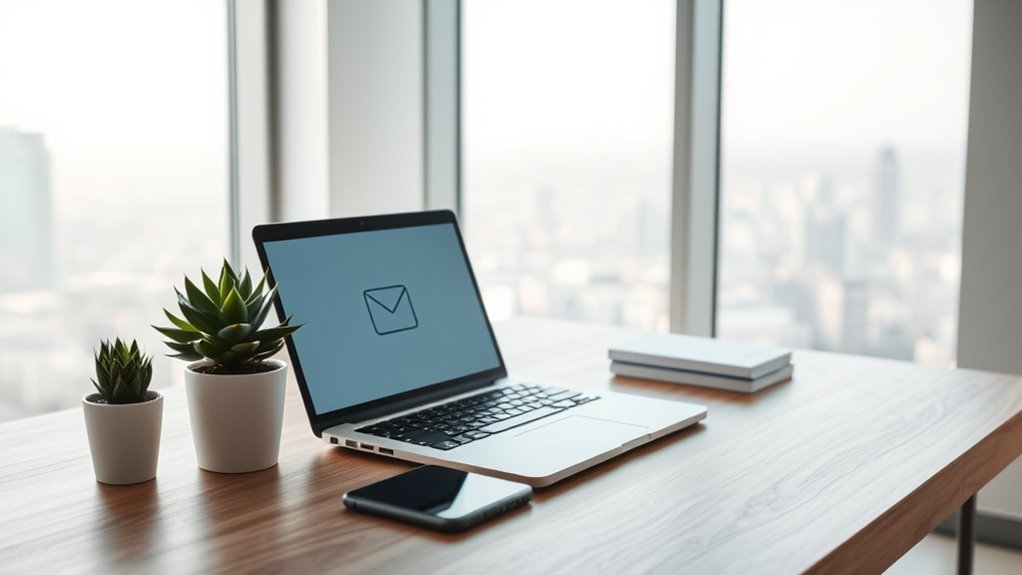
Managing notifications effectively is essential if you want to minimize distractions and stay focused. Start by turning off non-essential alerts on your devices. Only keep notifications for critical messages or those from trusted contacts. Use settings to customize which apps can send alerts, reducing interruptions during deep work periods. Consider batching notifications so you review them at designated times instead of constantly responding. Silence notifications during focused work sessions or meetings to preserve concentration. Regularly review your notification settings to verify they align with your current priorities. Remember, the goal is to control what pulls your attention, not eliminate all alerts entirely. By managing notifications thoughtfully, you create a calmer inbox environment that supports sustained focus and productivity.
Regularly Reviewing and Archiving Messages
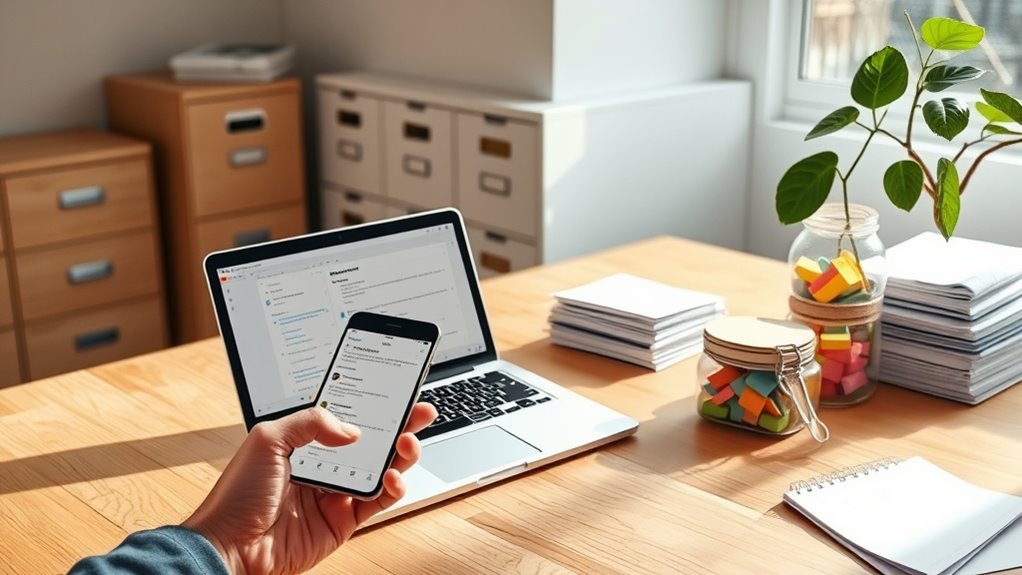
To maintain an organized inbox, it’s essential to review your messages regularly and archive those that no longer require immediate attention. This keeps your inbox manageable and prevents clutter from building up. Set aside a few minutes daily or weekly to scan your inbox, identify messages that are resolved or no longer relevant, and archive them. Archiving doesn’t delete these messages but keeps them accessible if needed later. This process helps you focus on current tasks and reduces mental overload.
Regularly review and archive emails to stay organized and reduce mental clutter.
- Quickly scan for important or urgent emails
- Delete unnecessary or outdated messages
- Archive completed conversations for future reference
- Use filters to automatically categorize messages
Cultivating Long-Term Email Wellness Habits
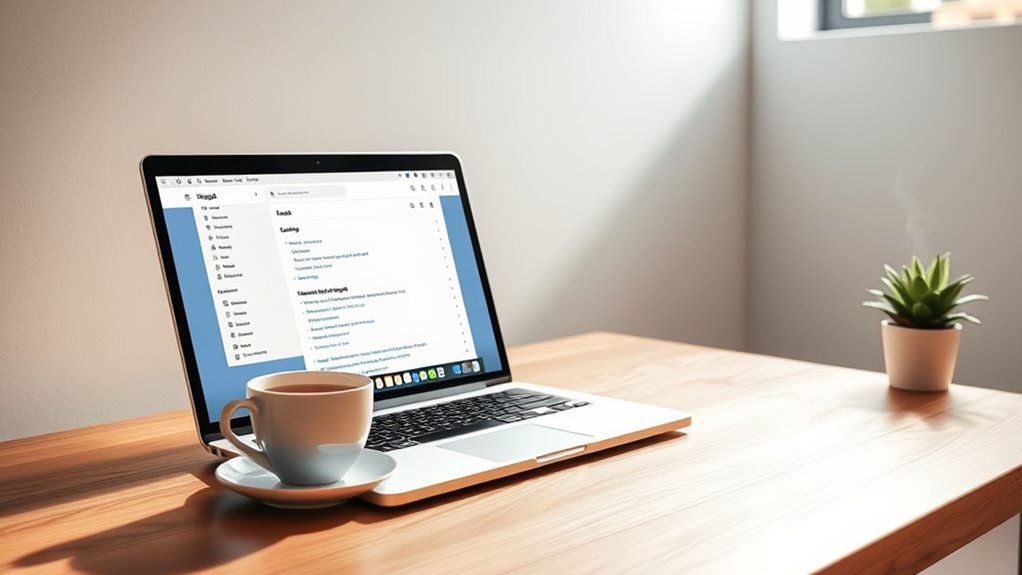
Building long-term email wellness habits requires you to review your inbox regularly and stick to a routine. When you establish consistent habits, managing your email becomes automatic rather than burdensome. Stay committed to these practices, and you’ll maintain a healthier, more organized inbox over time.
Consistent Email Review
Have you developed a routine for reviewing your inbox regularly? Consistent email review keeps your inbox manageable and prevents clutter from piling up. Set aside specific times each day to check and process emails, so it becomes a habit rather than an afterthought. By doing this, you stay on top of important messages and reduce the stress of unread emails.
Here are some tips to maintain a steady review process:
- Schedule fixed review times daily or multiple times a day
- Quickly scan for urgent or important emails first
- Use a triage system: delete, delegate, or respond promptly
- Archive or categorize emails for future reference
Regular review helps you stay organized, reduces overwhelm, and supports long-term email wellness habits.
Establishing Routine Habits
Establishing routine habits is essential for maintaining long-term email wellness because consistent practices turn momentary efforts into lasting behaviors. When you set specific times each day to check and process your inbox, you create a predictable rhythm that prevents backlog. Make it a habit to review new emails, delete unnecessary messages, and respond promptly to important ones. Incorporate small routines, like unsubscribing from unwanted mailing lists or organizing emails into folders immediately. Over time, these habits become automatic, reducing stress and preventing clutter from accumulating. Stay disciplined by sticking to your schedule even during busy days. Consistent routines strengthen your inbox management skills, making email less overwhelming and more manageable, ultimately supporting your goal of sustainable email wellness.
Frequently Asked Questions
How Can I Balance Inbox Zero With Urgent, Ongoing Projects?
Balancing inbox zero with urgent, ongoing projects can be tricky. You should prioritize emails based on deadlines and importance, setting specific times to check and respond. Use filters and labels to organize messages, so you don’t get overwhelmed. Focus on high-priority tasks first, and defer less urgent ones. Remember, it’s okay to leave some emails for later, as long as you stay consistent with your sorting and follow-up.
What Are the Psychological Impacts of a Cluttered Versus an Organized Inbox?
You might think a cluttered inbox only causes frustration, but it also increases stress and decreases your focus. An organized inbox gives you a sense of control, boosts confidence, and improves mental clarity. While some believe tech solutions fix everything, maintaining habits that keep your inbox tidy supports long-term well-being. With consistent effort, you’ll feel more productive and less overwhelmed, making your digital space a source of calm rather than chaos.
How Do I Handle Email Overload During Peak Work Periods?
During peak work periods, you can manage email overload by setting specific times to check your inbox, rather than constantly monitoring it. Use filters and labels to prioritize important messages, and unsubscribe from unnecessary newsletters. Turn off email notifications to stay focused, and consider batching your responses. These strategies help you stay organized, reduce stress, and maintain productivity, even when your inbox is flooding with new messages.
What Strategies Ensure Long-Term Email Management Sustainability?
Did you know that 40% of emails go unread? To keep your email habits sustainable, set specific times to check your inbox and stick to them. Use filters and labels to prioritize important messages and unsubscribe from unnecessary lists. Regularly declutter your inbox, and avoid responding immediately to non-urgent emails. These habits help you manage emails efficiently and prevent overload in the long run.
Which Tools Best Support Personalized Email Filtering and Sorting?
You want tools that help you personalize email filtering and sorting. Consider using Gmail’s filters and labels for customized organization, or Outlook’s rules to automatically sort incoming messages. Email management apps like SaneBox or Spark offer smart filtering features that adapt to your habits. These tools streamline your inbox, making it easier to prioritize important emails and reduce clutter, helping you stay organized and efficient.
Conclusion
Think of your inbox as a garden. With regular weeding—sorting, archiving, and clearing—you keep it vibrant and thriving. Don’t let clutter overrun your space; instead, nurture it with smart habits and automation. By tending to your email garden daily, you’ll enjoy a peaceful, productive landscape where everything blooms in harmony. Embrace these sustainable habits, and your inbox will become a well-tended sanctuary rather than a wild jungle.

